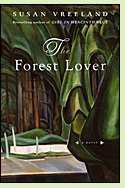The Forest Lover
by Susan Vreeland
Reviewed by Margaret Tomlinson

The Forest Lover is about Canadian artist Emily Carr. Born and raised in British Columbia by English-born parents who held to English customs and traditions, she began painting seriously after both her parents died while she was a teen and her guardians allowed her to attend art school in San Francisco. In her twenties, she began sketching and painting Native American settlements, an interest that most Canadians of European descent found distasteful. Carr managed a year in France in 1910, studying and experimenting with post-Impressionist styles and techniques. A highly productive period followed: she painted totem poles, other Native American subjects, and the forests and shores of the Pacific Northwest, developing her own post-Impressionist style. Her work, however, was either ignored or panned by Canadian art critics. In 1913, she gave up painting so she could support herself in more prosaic ways. That would change - but not until she was in her mid-fifties.
This cleanly, sometimes lyrically written portrayal of Carr's life as an artist invents a few fictional characters and imagines lives for some historical people about whom little is recorded. No novel, however carefully researched (as this one is), should be confused with biography. The value of biographical fiction lies in its ability to convey the emotional texture of a person's life in a way that factual accounts - necessarily omitting unshared private conversations and inner thoughts and feelings - cannot.
The Forest Lover brings alive Carr's warm feelings for her Native American neighbors, her love of their art - so despised by most white settlers of Carr's time - and the vision, determination and tiny scraps of encouragement that made it possible for Carr to keep painting as long as she did. Today she is considered one of the most important Canadian painters of the twentieth century. Vreeland's novel about how that happened makes absorbing, satisfying reading, especially for other creative spirits. (2004; 420 pages including an Author's Afterword separating history from fiction)
More about The Forest Lover at Powell's Books or Amazon.comOther novels about artists:
The Fountain of St. James Court; or, Portrait of the Artist as an Old Woman by Sena Jeter Naslund (2013), about the eighteenth-century French painter Élisabeth Vigée-Le Brun, and a present-day writer. See review or more info at Powell's Books
Sunflowers by Sheramy Bundrick (2009), about Vincent van Gogh. See review or more info at Powell's Books
Lydia Cassatt Reading the Morning Paper by Harriett Scott Chessman (2002), about the American Impressionist painter Mary Cassatt. More info
Nonfiction about Emily Carr:
The Art of Emily Carr by Doris Shadbolt (1979). More info
Growing Pains by Emily Carr (1945), Carr's autobiography. More info
Extraordinary Canadians: Emily Carr: A Penguin Lives Biography by Lewis De Soto (2008). More info
Emily Carr: At the Edge of the World by Jo Ellen Bogart and Maxwell Newhouse (2003), recommended for ages 10-15. More info
Online:
Emily Carr at the Canadian Encyclopedia website
Back to Twentieth Century North America, Before the Wars
Back to Directory of Book Reviews